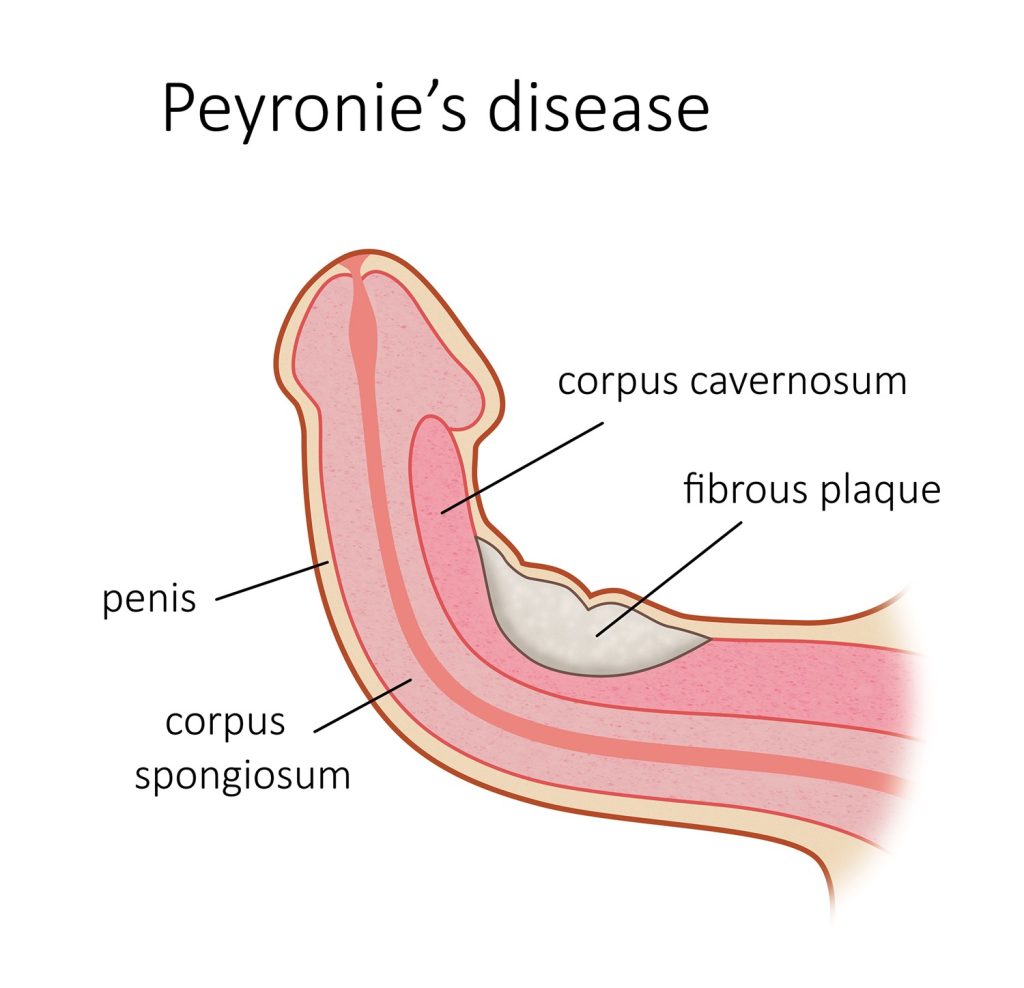What is Peyronie’s Penile Curvature Treatment
The penis is composed of two cavernous bodies, of a mass of spongy tissue surrounding the urethra (the tube through which urine flows), and of a glans, or head, at the tip. The two cavernous bodies are covered by a thick, elastic membrane called the tunica albuginea, which creates an erection by increasing the penis’ girth and length. Peyronie’s disease is caused by the development of localized fibrous segments in the tunica albuginea of the sponge-like region of the penis which in turn causes it to curve during an erection.


What causes the disease?
It has no known causes, but 37% of the many existing hypotheses involve trauma.
Are there any predispositions to the disease?
Approximately 10% of men with Peyronie's also develop Dupuytren's contracture. Diabetes, smoking, the use of beta blockers, Paget's disease and rheumatoid arthritis can contribute to the development of the disease.
What is its rate of occurrence?
The incidence of Peyonie's disease is 7%. It usually develops at the age of 53 on average, and is considered rare before the age of 40.
How does the disease evolve?
Changes in the penile curvature can vary over time. Curvature may spontaneously disappear just as much as it can evolve into severe deformity. Determining how curvature will evolve in the disease's early stages is therefore difficult.
Peyronie's disease usually evolves in two phases:
Acute phase The initial inflammatory phase may be accompanied by painful erections, the formation of a lump along the shaft and a change in the curvature of the penis during erection. Pain may occur randomly or only during an erection. In the majority of cases, pain seems to disappear within 12 to 18 months.
Chronic phase The chronic phase is characterized by stable curvature. Patients often do not feel pain at this stage.
Peyronie's disease usually evolves in two phases:
Acute phase The initial inflammatory phase may be accompanied by painful erections, the formation of a lump along the shaft and a change in the curvature of the penis during erection. Pain may occur randomly or only during an erection. In the majority of cases, pain seems to disappear within 12 to 18 months.
Chronic phase The chronic phase is characterized by stable curvature. Patients often do not feel pain at this stage.
How is the disease diagnosed?
The urologist can diagnose Peyronie's disease based on a patient's medical history or through a physical examination. Diagnostic tests are not necessary.
How is Peyronie's medically treated?
During the acute phase: nonsurgical shock wave therapyis used to reduce pain.
During the chronic phase: plication surgery is carried out in order to correct penile curvature.
During the chronic phase: plication surgery is carried out in order to correct penile curvature.
Are there any plaque injection treatments available?
Collagenase (medication injected directly into plaques) is not accessible yet in Canada (XIAFLEX).
In many studies, it has been proven to reduce curvature and plaque size, and improve erectile dysfunction. This treatment is rather expensive.
Infiltration of platelet-rich plasma with hyaluronic acid is a new treatment, now accepted by Health Canada. It consists in taking a blood sample that is centrifuged to get the plasma on the surface. The patient’s plasma is collected and reinjected in the plaque site. This treatment is offered in private practice at Dr Carlos Marois Urologue’s clinics.
The infiltration is done under local anesthesia with a penile block. The procedure is performed under ultrasound guidance in order to identify the plaque. Several sessions, approximately 4, are required every 2 weeks. A penis expander can be used in combination to improve results. It is sometimes necessary to perform a maintenance treatment every month until the disease stabilises. The satisfaction rate is high, with a correction of about 15 % of the curvature in 75 % of treated patients.
In many studies, it has been proven to reduce curvature and plaque size, and improve erectile dysfunction. This treatment is rather expensive.
Infiltration of platelet-rich plasma with hyaluronic acid is a new treatment, now accepted by Health Canada. It consists in taking a blood sample that is centrifuged to get the plasma on the surface. The patient’s plasma is collected and reinjected in the plaque site. This treatment is offered in private practice at Dr Carlos Marois Urologue’s clinics.
The infiltration is done under local anesthesia with a penile block. The procedure is performed under ultrasound guidance in order to identify the plaque. Several sessions, approximately 4, are required every 2 weeks. A penis expander can be used in combination to improve results. It is sometimes necessary to perform a maintenance treatment every month until the disease stabilises. The satisfaction rate is high, with a correction of about 15 % of the curvature in 75 % of treated patients.
Can Peyronie's be physically treated?
Extracorporeal shock wave lithotripsy seems to reduce the pain more quickly during the acute phase. This treatment is available through private practice at Dr Carlos Marois' urology clinics. A four-week series of weekly, half-hour appointments are required to treat plaque.


